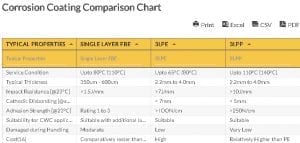Corrosion Coating Comparison Chart

Corrosion Coating Comparison Chart presents information comparing different properties like Single Layer FBE, 3LPE, and 3LPP.
Most of the time, a corrosion coating helps protect metal materials from breakage due to detrimental factors such as moisture, oxidation, and harmful industrial chemicals. This coating is added to the surface and acts as a barrier to impede chemicals and corrosive materials.
Corrosion Coating Comparison Discussion
This is significantly helpful in any industry, especially the field of gas and oil. It helps maintain the efficiency and extends the longevity of the pipe used for transporting fluids.
Types of Corrosion Coating
Single Layer FBE
It is also known as Fusion Bonded Epoxy coating. It is a powder coating commonly used to give security to steel pipe and pipelines. This coating is originally a thermoset polymer. This environmentally safe coating is applied on the surface of the pipe create a durable barrier. For the coating to be efficient, it has to reach a target temperature that ranges from 180 to 250 Celsius.
3LPE and 3LPP
These corrosion coatings are multilayer coatings that consist of three functional elements. The first element is the FBE that works as a primer and should be 150 microns thick. It is followed by an adhesive called copolymer with 200 microns thickness, and polyethylene as the last layer which gives durable protection. The standards and codes for these are DIN 30670 or CAN/CSA Z245.21 and ISO 21809-1.
Corrosion Coating Benefits
Aside from keeping the pipe safe, corrosion coatings have other benefits to customers.
1. It eliminates large repair expenses.
Pipe that are damaged greatly due to chemical factors are subject to an expensive replacement operation. However, opting for this product can reduce the cost by giving extra protection.
2. It avoids delay in operation.
As pipe replacement or maintenance takes hours to complete, it will result in delayed operation. Coatings will help prevent that delay of production.
3. It results in less friction.
For some operations, friction can be the cause why parts are moving slowly. Having a corrosion barrier will minimize the friction between surfaces.
4. It is non-flammable.
Some anti-corrosion agents are made with a flame spread rate of 0. This means that the product is fireproof.
Corrosion Coating Comparison Chart
| Typical Properties | Single Layer FBE | 3LPE | 3LPP | |
|---|---|---|---|---|
| wdt_ID | Typical Properties | Single Layer FBE | 3LPE | 3LPP |
| 1 | Service Condition | Upto 80°C (110°C) | Upto 65°C (80°C) | Upto 110°C (140°C) |
| 2 | Typical Thickness | 350um - 600um | 2.2mm to 4.0mm | 2.2mm to 4.0mm |
| 3 | Impact Resistance [@23°C] | >1.5J/mm | >7J/mm | >10J/mm |
| 4 | Cathodic Disbonding [@approx. 23°c for 28days] | < 7mm | < 5mm | |
| 5 | Adhesion Strength [@23°C] | Rating 1 to 3 | > lOON/cm | >250N/cm |
| 6 | Suitability tor CWC application or HDD or similar | Suitable with additional layer | Suitable | Suitable |
| 7 | Damaged during Handling | Moderate | Low | Very Low |
| 8 | Cost(16) | Comparatively lesser than PE | High | Relatively Higher than PE |
Corrosion Coating Comparison Chart
| Typical Properties | Single Layer FBE | 3LPE | 3LPP | |
|---|---|---|---|---|
| wdt_ID | Typical Properties | Single Layer FBE | 3LPE | 3LPP |
| 1 | Service Condition | Upto 80°C (110°C) | Upto 65°C (80°C) | Upto 110°C (140°C) |
| 2 | Typical Thickness | 350um - 600um | 2.2mm to 4.0mm | 2.2mm to 4.0mm |
| 3 | Impact Resistance [@23°C] | >1.5J/mm | >7J/mm | >10J/mm |
| 4 | Cathodic Disbonding [@approx. 23°c for 28days] | < 7mm | < 5mm | |
| 5 | Adhesion Strength [@23°C] | Rating 1 to 3 | > lOON/cm | >250N/cm |
| 6 | Suitability tor CWC application or HDD or similar | Suitable with additional layer | Suitable | Suitable |
| 7 | Damaged during Handling | Moderate | Low | Very Low |
| 8 | Cost(16) | Comparatively lesser than PE | High | Relatively Higher than PE |
Corrosion Coating Comparison Chart Abbreviations:
- F.B.E. – Fusion Bonded Epoxy
- 3L.P.E. – Three-Layer Polyethylene
- 3L.P.P. – Three Layer Propylene
- µm – micrometer
- mm – millimeter
- N/cm – Newton per centimeter
- H.D.D. – Horizontal Direct Drilling
- P.E. – Plain Ends
Terms Used for Corrosion Coating Types
- FBE – Fusion Bonded Epoxy
- 3LPE – Three-Layer Polyethylene
- 3LPP – Three Layer Propylene
Go here if you are looking for the Coating Thermal Stress Chart.


